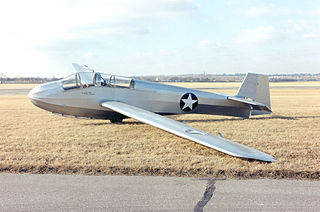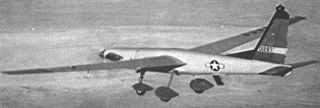
The Lockheed S-3 Viking is a four-crew, twin-engine turbofan-powered jet aircraft designed and produced by the American aerospace manufacturer Lockheed Corporation. Because of its characteristic sound, it was nicknamed the "War Hoover" after the vacuum cleaner brand.

The RQ-3 DarkStar is an unmanned aerial vehicle (UAV). Its first flight was on March 29, 1996. The Department of Defense terminated DarkStar in January 1999, after determining the UAV was not aerodynamically stable and was not meeting cost and performance objectives.

The Lockheed P-3 Orion is a four-engined, turboprop anti-submarine and maritime surveillance aircraft developed for the United States Navy and introduced in the 1960s. Lockheed based it on the L-188 Electra commercial airliner; it is easily distinguished from the Electra by its distinctive tail stinger or "MAD" boom, used for the magnetic anomaly detection (MAD) of submarines.

The Lockheed EP-3 is an electronic signals reconnaissance variant of the P-3 Orion, primarily operated by the United States Navy.

The Schweizer Aircraft Corporation was an American manufacturer of sailplanes, agricultural aircraft and helicopters located in Horseheads, New York. It was incorporated in 1939 by three Schweizer brothers, who built their first glider, the SGP 1-1, in 1930. Previously the oldest privately owned aircraft company in the United States, Schweizer was acquired by Sikorsky Aircraft Corporation of Stratford, Connecticut in 2004, and became a diversified aerospace company. Schweizer Aircraft ceased operations in 2012. It was sold to Schweizer RSG in 2018 and production lines were opened in Fort Worth, Texas. The company was producing two helicopter models in 2021. The 300C and 300CBI

The X-26 Frigate is the longest-lived of the X-plane programs. The program included the X-26A Frigate sailplane and the motorized X-26B Quiet Thruster versions: QT-2, QT-2PC, and QT-2PCII. All were based on the Schweizer SGS 2-32 sailplane.

The Lockheed C-141 Starlifter is a retired military strategic airlifter that served with the Military Air Transport Service (MATS), its successor organization the Military Airlift Command (MAC), and finally the Air Mobility Command (AMC) of the United States Air Force (USAF). The aircraft also served with airlift and air mobility wings of the Air Force Reserve (AFRES), later renamed Air Force Reserve Command (AFRC), the Air National Guard (ANG) and, later, one air mobility wing of the Air Education and Training Command (AETC) dedicated to C-141, C-5, C-17 and KC-135 training.

The Lockheed AH-56 Cheyenne was an attack helicopter developed by Lockheed for the United States Army. It rose from the Army's Advanced Aerial Fire Support System (AAFSS) program to field the service's first dedicated attack helicopter. Lockheed designed the Cheyenne using a four-blade rigid-rotor system and configured the aircraft as a compound helicopter with low-mounted wings and a tail-mounted thrusting propeller driven by a General Electric T64 turboshaft engine. The Cheyenne was to have a high-speed dash capability to provide armed escort for the Army's transport helicopters, such as the Bell UH-1 Iroquois.

Castle Air Museum is a military aviation museum located in Atwater, California, United States adjacent to Castle Airport, a former United States Air Force Strategic Air Command base which was closed in 1995, after the end of the Cold War. It is one of the largest aerospace museums displaying vintage aircraft in the western United States.

The Lockheed XH-51 was an American single-engine experimental helicopter designed by Lockheed Aircraft, utilizing a rigid rotor and retractable skid landing gear. The XH-51 was selected as the test vehicle for a joint research program conducted by the United States Army and United States Navy to explore rigid rotor technology.

The Sikorsky S-69 is an American experimental co-axial compound helicopter developed by Sikorsky Aircraft as the demonstrator of the Advancing Blade Concept (ABC) under United States Army and NASA funding.

The Doak VZ-4 was an American prototype Vertical Takeoff and Landing (VTOL) aircraft built in the 1950s for service in the United States Army. Only a single prototype was built, and the U.S. Army withdrew it from active trials in 1963.

The Schweizer SGS 2-12 is a United States two-seat, low-wing, training glider built by Schweizer Aircraft of Elmira, New York.

The Schweizer SGS 2-32 is an American two-seat, mid-wing, two or three-place glider built by Schweizer Aircraft of Elmira, New York.

The Ling-Temco-Vought XQM-93 was a remotely piloted aircraft developed in the United States in the late 1960s and early 1970s for use as a communications relay in the Vietnam War. A prototype flew in 1970, but the program was abandoned without producing a service-ready aircraft.
The Martin Marietta Model 845 was a remotely piloted aircraft developed in the United States in the late 1960s and early 1970s for use as a communications relay in the Vietnam War.

The LTV L450F, also known as the L45ØF, was a prototype quiet reconnaissance aircraft, developed by Ling-Temco-Vought in the late 1960s for use in the Vietnam War by the United States. Based on the airframe of a Schweizer 2-32 sailplane, the aircraft flew in 1970, and was developed into the XQM-93 reconnaissance drone before the project was cancelled.

The Allison T56 turboprop engine has been developed extensively throughout its production run, the many variants are described by the manufacturer as belonging to four main series groups.


















